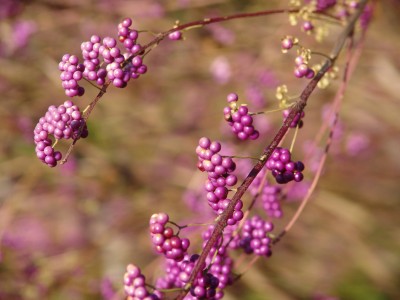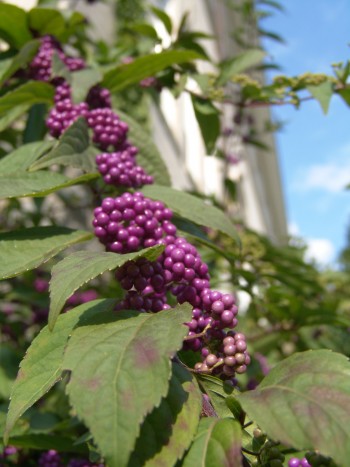Callicarpa dichotoma 'Issai'
 Purple happens to be my favorite color, and I believe this preference is finding its way into my Plant of Month selections. I am noticing a trend: In July, I wrote about the purple coneflower, Echinacea; next month was the unique purple-tinged Angelica gigas; and last month, I branched out a bit and covered a blue-purple aster cultivar. Now that November is upon us, I once again find myself drawn to all things purple. Even as I look outside the office window down to the Terry Shane Teaching garden, and see the deep hue of our Acer palmatum ‘Crimson Queen’ and the bright reds of our newly planted specimens of Ilex verticillata ‘Red Sprite’, I can’t help but be drawn to the lustrous purple berries of this month’s Plant of the Month pick, Callicarpa dichotoma ‘Issai’, or purple beautyberry.
Purple happens to be my favorite color, and I believe this preference is finding its way into my Plant of Month selections. I am noticing a trend: In July, I wrote about the purple coneflower, Echinacea; next month was the unique purple-tinged Angelica gigas; and last month, I branched out a bit and covered a blue-purple aster cultivar. Now that November is upon us, I once again find myself drawn to all things purple. Even as I look outside the office window down to the Terry Shane Teaching garden, and see the deep hue of our Acer palmatum ‘Crimson Queen’ and the bright reds of our newly planted specimens of Ilex verticillata ‘Red Sprite’, I can’t help but be drawn to the lustrous purple berries of this month’s Plant of the Month pick, Callicarpa dichotoma ‘Issai’, or purple beautyberry.
Purple beautyberry, a deciduous shrub, is most striking during late autumn, when it drops its foliage for the season but holds onto its distinctive violet-colored berries as a key identifying feature. There are numerous accepted species of Callicarpa; however, the Pennsylvania Horticultural Society awarded Gold Medal status to Callicarpa dichotoma in the late 1980s, for its notably large berry clusters and gracefully arching branches. ‘Issai’ is best known for its early and plentiful fruit crop.
C. dichotoma ‘Issai’ is a fast-growing plant that prefers full to part sun; more sun exposure will result in heavier fruiting and better fruit color. The foliage, when present on the plant, provides a nice architectural appearance, because the leaves are oriented on a single plane rather than radiating all around the stem. Before producing its notable berries in early fall, C. dichotoma produces summer-time pinky-lavender flat-topped flower clusters (also known as cymes) above its structural foliage.
At the Scott Arboretum, we cut our plants back to twelve inches in March, since they fruit and flower on new wood. This is a way to keep the plant to maximum size of four feet. Callicarpa dichotoma ‘Issai’ specimens can be found around the periphery of the Nason Garden. P.S. – While you’re there, be sure to also take in the beautiful yellow fall display of Amsonia hubrichtii, the thread-leaf bluestar (it may not be purple, but it is yet another fall-time show-stopper).






No Comments